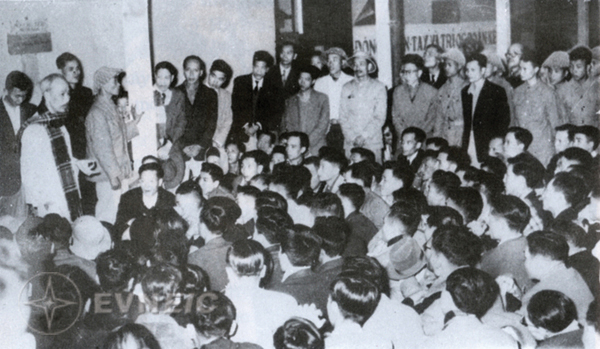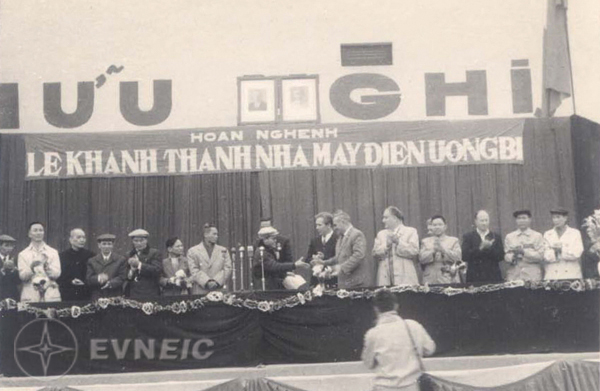1. President Ho Chi Minh visits power sector

Photo credit: Tran Nguyen Hoi
On December 21, 1954, just over two months after the Liberation of the Capital, President Ho Chi Minh visited Yen Phu Power Plant and Bo Ho Power Plant. At this warm gathering, he remarked:
"This plant now belongs to the people, to the Government, to you. As the owners, you must safeguard it and make it grow even stronger…” Since then, December 21 has been regarded as the Traditional Day of Vietnam’s Power sector.
2. Establishment of first state management agency specializing in electricity
On July 21, 1955, the Minister of Industry and Trade issued Decision No. 169-BCT/ND/KB (signed by Deputy Minister Dang Viet Chau) to establish the Department of Electricity under the Ministry of Industry and Trade, appointing Mr. Ho Quy Dien as Director General. This event marked a legal milestone in the directive and management functions of the first state authority specialized in the electricity sector. On February 21, 1961, the Ministry of Water Resources and Electricity issued Decision No. 86-TLDL/QD, upgrading the Department of Electricity into the General Department of Electricity. On December 28, 1962, the Government Council decided to transfer the General Department of Electricity from the Ministry of Water Resources and Electricity to directly report to the Ministry of Heavy Industry, later renamed back to the Department of Electricity. On October 6, 1969, the Ministry of Electricity and Coal issued Decision No. 106/QD/TC to establish the Electricity Company (now Electricity Company No. 1) under the ministry, tasked with electricity production and business, operating under the financial autonomy regime. In 1981, the Ministry of Electricity was officially established.
3. Doubling nation’s total power source capacity compared to 1954
Upon the Liberation of the Capital in October 1954, the installed capacity of the power sector was only 31.5MW, with annual electricity production of about 53 million kWh. Between 1956 and 1958, after consolidating post-liberation management structures and upgrading plants and transmission lines left behind by the French, three new thermal power plants were simultaneously commenced: Vinh Power Plant (8MW), Thanh Hoa Power Plant (6MW), and Lao Cai Power Plant (8MW). These projects doubled the national source capacity compared to 1954. This was a critical starting point, laying the foundation for the strong development of Vietnam’s power source and grid system in subsequent years.
4. Construction of first 35kV medium-voltage transmission line
In January 1958, construction began on the first 35kV transmission line (Hanoi - Pho Noi), which was successfully completed and energized in the third quarter of the same year. Before that, following the Liberation of the Capital, old 30.5kV lines were rehabilitated and upgraded to 35kV; transmission lines such as Hanoi - Ha Dong, Hanoi - Son Tay, Hanoi - Pho Noi, Thai Binh - Nam Dinh… were restored and put back into operation.
5. Construction of Uong Bi Thermal Power Plant - first large-capacity thermal power plant in the North

Photo credit: Tran Nguyen Hoi
On May 19, 1961, construction of the Uong Bi Thermal Power Plant, with a capacity of 48MW, commenced. The plant was inaugurated and commissioned in 1963. This was the largest-capacity thermal power plant in Northern Vietnam during the early years of socialist construction. The plant was built with assistance from the Soviet Union, which provided equipment and training for staff and workers. It became one of the key power sources supporting the building of socialism in the North. Later, the plant’s capacity was expanded to 153MW. In May 2002, the Uong Bi Thermal Power Plant Expansion Project, with a capacity of 300MW (1 unit) and investment of over USD 300 million, was commenced with EVN as investor. The plant has since entered commercial operation. Currently, EVN is continuing investment in the Uong Bi Thermal Power Plant Expansion 2, also with a capacity of 300MW.
6. Construction of first 110kV transmission lines in the North
In Quarter 3 of 1962, construction began on the first 110kV transmission lines in the North (Dong Anh - Viet Tri, Uong Bi - Hai Phong). By Quarter 4 of 1963, these lines were completed and energized. Subsequently, many power plants, 110kV and 35kV transmission lines, and substations were constructed. Nine out of twelve power plants were interconnected through 110kV lines, forming a complete power system in Northern Vietnam. This was the most vibrant development stage of the power system before the United States began its bombing campaign against the North.
7. Construction of Thac Ba Hydropower Plant - first large hydropower plant in the North
On August 19, 1964, construction commenced on the Thac Ba Hydropower Plant (Yen Bai) with a capacity of 108MW. The plant’s first phase was inaugurated and put into operation on October 5, 1971. This was the first large-capacity hydropower plant in Vietnam, built with assistance from the Soviet Union. After the U.S. bombing campaign against the North, the Thac Ba Hydropower Plant was fully restored, and by early 1973, all three generating units had resumed operation.
Translator: Thu Hường
Share